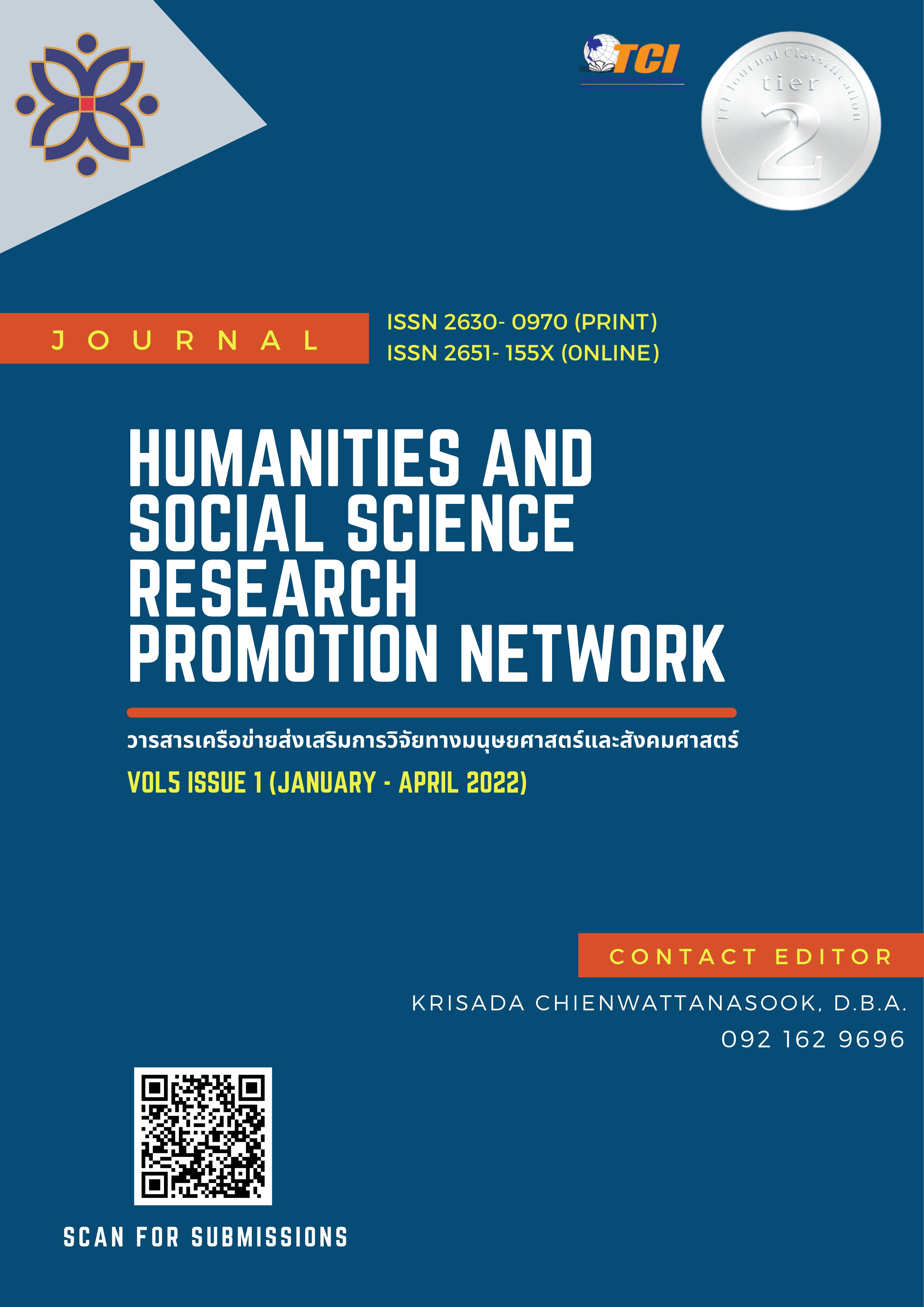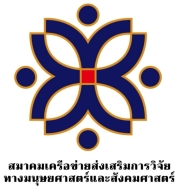EMPLOYEE WELLNESS AFTER ORGANIZATIONAL RESTRUCTURING IMPACTS ON EMPLOYEE PERFORMANCE
Keywords:
Organizational Restructuring, Employee Performance, Employee HealthAbstract
Due to the COVID-19 epidemic, many organizations have to adapt in order to cope with changes in their business environment. Organizational restructuring is one of the corporate management techniques that affects the well-being of employees. Also, the health of the employees affects their work in both positive and negative ways. Therefore, this research aimed to investigate the work-related and psychological well-being factors of employees after organizational restructuring that affects employee performance. In this study, the questionnaire was used to collect data of 400 employees who are working at the Electricity Generating Authority of Thailand. Data were analyzed by using frequency distribution, percentage, mean, standard deviation, correlation coefficient analysis, and multiple regression analysis. Statistical significance was determined through a 95% confidence level.
Regarding the level of employees’ opinions towards the work-related and psychological well-being factors of employees after organizational restructuring, the results indicated that job satisfaction, job participation, and work happiness highly impact employees’ feelings. The stress in the workplace moderately impacts employees’ feelings, whereas insecurity in the job has a low impact on them. From the multiple regression analysis, it was found that the effect of the employee well-being that had a positive effect on employees' performance at a statistically significant level of 0.05 was job participation and work happiness. Other aspects include job satisfaction, job insecurity, and stress did not find a significant in employees' performance.
References
Achor, S. (2011). The happiness advantage: The seven principles of positive psychology that fuel success and performance at work: Random House.
Alvi, S., A. N. Butt & A. Khurshid. (2013). Beaconhouse school system (bss) restructuring. Asian Journal of Management Cases, 10(2), 113-124.
Allen, T. D., Freeman, D. M., Russell, J. E., Reizenstein, R. C., & Rentz, J. O. (2001). Survivor reactions to organizational downsizing: Does time ease the pain?. Journal of Occupational and Organizational Psychology, 74(2), 145-164.
Bakker, A. B., Schaufeli, W. B., Leiter, M. P., & Taris, T. W. (2008). Work engagement: An emerging concept in occupational health psychology. Work & Stress, 22(3), 187-200.
Boonsiritomachai, W., & Sud-On, P. (2021). The moderation effect of work engagement on entrepreneurial attitude and organizational commitment: evidence from Thailand’s entry-level employees during the COVID-19 pandemic. Asia-Pacific Journal of Business Administration, 14(1), 50-71.
Boonsiritomachai, W., & Trongpraween, T. (2020). The Effect of Team Affective Tone on Team Efficiency. Business Review Journal, 12(2), 83-97.
Bowman, E. H., & Singh, H. (1993). Corporate restructuring: Reconfiguring the firm. Strategic Management Journal, 14(S1), 5-14.
Brockner, J., Spreitzer, G., Mishra, A., Hochwarter, W., Pepper, L., & Weinberg, J. (2004). Perceived control as an antidote to the negative effects of layoffs on survivors' organizational commitment and job performance. Administrative Science Quarterly, 49(1), 76-100.
Brown, S. P., & Leigh, T. W. (1996). A new look at psychological climate and its relationship to job involvement, effort, and performance. Journal of applied psychology, 81(4), 358.
Burke, R. J., & Cooper, C. L. (2000). The new organizational reality: Transition and renewal. The organization in crisis: Downsizing, restructuring, and privatization. Oxford: Blackwell. 3-19.
Crossman, A., & Abou‐Zaki, B. (2003). Job satisfaction and employee performance of Lebanese banking staff. Journal of Managerial Psychology, 18(4), 268-376.
Daft, R. (2008). New Era of Management, 2nd International Edition. Thompson South-Western, Mason.
Datta, D. K., Guthrie, J. P., Basuil, D., & Pandey, A. (2010). Causes and effects of employee downsizing: A review and synthesis. Journal of Management, 36(1), 281-348.
De Cuyper, N., De Witte, H., Vander Elst, T., & Handaja, Y. (2010). Objective threat of unemployment and situational uncertainty during a restructuring: Associations with perceived job insecurity and strain. Journal of Business and Psychology, 25(1), 75-85.
de Jong, T., Wiezer, N., de Weerd, M., Nielsen, K., Mattila-Holappa, P., & Mockałło, Z. (2016). The impact of restructuring on employee well-being: a systematic review of longitudinal studies. Work & Stress, 30(1), 91-114.
Diener, E. (2000). Subjective well-being: The science of happiness and a proposal for a national index. American Psychologist, 55(1), 34-43.
Ding, A. W., & Li, S. (2021). National response strategies and marketing innovations during the COVID-19 pandemic. Business horizons, 64(2), 295-306.
Erkama, N. (2010). Power and resistance in a multinational organization: Discursive struggles over organizational restructuring. Scandinavian Journal of Management, 26(2), 151-165.
Field, L. K., & Buitendach, J. H. (2011). Happiness, work engagement and organisational commitment of support staff at a tertiary education institution in South Africa. SA Journal of Industrial Psychology, 37(1), 01-10.
Fisher, C. D. (2010). Happiness at work. International Journal of Management Reviews, 12(4), 384-412.
Gandolfi, F., & Hansson, M. (2011). Causes and consequences of downsizing: Towards an integrative framework. Journal of Management & Organization, 17(4), 498-521.
Gavin, J. H., & Mason, R. O. (2004). The Virtuous Organization:: The Value of Happiness in the Workplace. Organizational Dynamics, 33(4), 379-392.
Häsänen, L., Hellgren, J., & Hansson, M. (2011). Goal setting and plant closure: When bad things turn good. Economic and Industrial Democracy, 32(1), 135-156.
Hills, P., & Argyle, M. (2002). The Oxford Happiness Questionnaire: a compact scale for the measurement of psychological well-being. Personality and individual differences, 33(7), 1073-1082.
Jalali, Z., & Heidari, A. (2016). The Relationship between Happiness, Subjective Well-Being, Creativity and Job Performance of Primary School Teachers in Ramhormoz City. International Education Studies, 9(6), 45-52.
Kahn, W. A. (1990). Psychological conditions of personal engagement and disengagement at work. Academy of Management journal, 33(4), 692-724.
Marques, T., Galende, J., Cruz, P., & Ferreira, M. P. (2014). Surviving downsizing and innovative behaviors: A matter of organizational commitment. International Journal of Manpower, 35(7), 930-955.
Money, K., Hillenbrand, C., & Da Camara, N. (2009). Putting positive psychology to work in organisations. Journal of General Management, 34(3), 31-36.
Munro, L., Rodwell, J., & Harding, L. (1998). Assessing occupational stress in psychiatric nurses using the full job strain model: the value of social support to nurses. International Journal of Nursing Studies, 35(6), 339-345.
Nahar, L., Hossain, A., Rahman, A., & Bairagi, A. (2013). The relationship of job satisfaction, job stress, mental health of government and non-government employees of Bangladesh. Psychology, 4(6), 520-525.
Richtnér, A., & Ahlström, P. (2006). Organizational downsizing and innovation. SSE/EFI Working Paper Series in Business Administration, 1, 1-22.
Rizwan, M., Khan, D., & Saboor, F. (2011). Relationship of job involvement with employee performance: Moderating role of attitude. European Journal of Business and Management, 3(8), 77-85.
Robbins, S. P., & Coulter, M. (2008). Personnel. Human Resources Management.
Roche, W. K., & Teague, P. (2014). Do recessions transform work and employment? Evidence from I reland. British Journal of Industrial Relations, 52(2), 261-285.
Ryan, R. M., & Deci, E. L. (2001). On happiness and human potentials: A review of research on hedonic and eudaimonic well-being. Annual review of psychology, 52(1), 141-166.
Saeed, K., & Farooqi, Y. A. (2014). Examining the relationship between work life balance, job stress and job satisfaction among university teachers (A case of University of Gujrat). International Journal of multidisciplinary sciences and engineering, 5(6), 9-15.
Sankar, M., & Revathy, B. (2018). The Organizational Structure Influences on Employees Satisfaction. Asian Journal of Management, 9(1), 569-572.
Sarstedt, M., Ringle, C. M., & Hair,. J. F. (2014). Partial Least Squares Structural EquationModeling. Handbook of Market Research, Springer International Publishing.
Seligman, M. E., & Csikszentmihalyi, M. (2014). Positive psychology: An introduction. In Flow and the foundations of positive psychology (pp. 279-298): Springer.
Sonnentag, S. (2003). Recovery, work engagement, and proactive behavior: a new look at the interface between nonwork and work. Journal of applied psychology, 88(3), 518-529.
Susniene, D., & Jurkauskas, A. (2009). The concepts of quality of life and happiness–correlation and differences. Engineering Economics, 63(3), 1-15.
Ting, K.-s. (2011). Research on the influence of organizational culture and organizational restructuring on organizational performance: Taking old folks nursing organization in Taiwan as an example. The Journal of Human Resource and Adult Learning, 7(2), 96-109.
Trevor, C. O., & Nyberg, A. J. (2008). Keeping your headcount when all about you are losing theirs: Downsizing, voluntary turnover rates, and the moderating role of HR practices. Academy of Management Journal, 51(2), 259-276.
Ugboro, I. O. (2016). Influence of managerial trust on survivors’ perceptions of job insecurity and organizational commitment in a post restructuring and downsizing environment. Journal of Behavioral and Applied Management, 4(3), 1077-1096.
Ur Rehman, W., & Naeem, H. (2012). The impact of downsizing on the performance of survived employees: A case study of Pakistan. African Journal of Business Management, 6(7), 2429-2434.
Wang, H.-j., Lu, C.-q., & Siu, O.-l. (2015). Job insecurity and job performance: The moderating role of organizational justice and the mediating role of work engagement. Journal of applied psychology, 100(4), 1249-1258.
Wiezer, N., Nielsen, K., Pahkin, K., Widerszal-Bazyl, M., de Jong, T., Mattila-Holappa, P., & Mockallo, Z. (2011). Exploring the link between restructuring and employee well-being: Työterveyslaitos.
Yamane, T. (1973). Statistics: an introductory analysis (3rd ed.). New York Harper and Row.
Zopiatis, A., Constanti, P., & Theocharous, A. L. (2014). Job involvement, commitment, satisfaction and turnover: Evidence from hotel employees in Cyprus. Tourism Management, 41, 129-140.
Downloads
Published
How to Cite
Issue
Section
License
Copyright (c) 2022 วรัญพงศ์ บุญศิริธรรมชัย, พลอย สุดอ่อน

This work is licensed under a Creative Commons Attribution-NonCommercial-NoDerivatives 4.0 International License.
บทความที่ได้รับการตีพิมพ์เป็นลิขสิทธิ์ของ ผู้เขียน
ทัศนะและความคิดเห็นที่ปรากฏในบทความในวารสารเครือข่ายส่งเสริมการวิจัยทางมนุษยศาสตร์และสังคมศาสตร์จะถือเป็นความรับผิดชอบของผู้เขียนบทความนั้น และไม่ถือเป็นทัศนะและความรับผิดชอบของกองบรรณาธิการ







